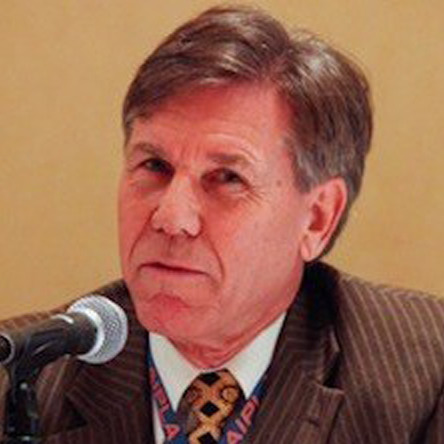
Hon. Randall R. Rader
Former Chief Judge (ret.)
U.S. Court of Appeals for the Federal Circuit
Randall R. Rader was appointed to the United States Court of Appeals for the Federal Circuit by President George H. W. Bush in 1990 and assumed the duties of Chief Circuit Judge on June 1, 2010 and retired from the bench on June 30, 2014. He was appointed to the United States Claims Court (now the U. S. Court of Federal Claims) by President Ronald W. Reagan in 1988.
Chief Judge Rader’s most prized title may well be “Professor Rader.” As Professor, Chief Judge Rader has taught courses on patent law and other advanced intellectual property courses at George Washington University Law School, University of Virginia School of Law, Georgetown University Law Center, the Munich Intellectual Property Law Center, and other university programs in Tokyo, Taipei, New Delhi, and Beijing. Due to the size and diversity of his classes, Chief Judge Rader may have taught patent law to more students than anyone else.
Chief Judge Rader has also co-authored several texts including the most widely used textbook on U. S. patent law, “Cases and Materials on Patent Law,” (St. Paul, Minn.: Thomson/West 3d ed. 2009) and “Patent Law in a Nutshell,” (St. Paul, Minn.: Thomson/West 2007) (translated into Chinese and Japanese).
Chief Judge Rader has won acclaim for leading dozens of government and educational delegations to every continent (except Antarctica), teaching rule of law and intellectual property law principles.
Chief Judge Rader has received many awards, including the Sedona Lifetime Achievement Award for Intellectual Property Law, 2009; Distinguished Teaching Awards from George Washington University Law School, 2003 and 2008 (by election of the students); the Jefferson Medal from the New Jersey Intellectual Property Law Association, 2003; the Distinguished Service Award from the Berkeley Center for Law and Technology, 2003; the J. William Fulbright Award for Distinguished Public Service from George Washington University Law School, 2000; and the Younger Federal Lawyer Award from the Federal Bar Association, 1983.
Before appointment to the Court of Federal Claims, Chief Judge Rader served as Minority and Majority Chief Counsel to Subcommittees of the U.S. Senate Committee on the Judiciary. From 1975 to 1980, he served as Counsel in the House of Representatives for representatives serving on the Interior, Appropriations, and Ways and Means Committees. He received a B.A. in English from Brigham Young University in 1974 and a J.D. from George Washington University Law School in 1978.

Recent Articles by Hon. Randall R. Rader
The U.S. Supreme Court’s flimsy eligibility jurisprudence offers the U.S. Court of Appeals for the Federal Circuit (CAFC) several “softball pitches” to avoid a patent bloodbath. To date, the Federal Circuit has struck out at preserving the patent system — at least twice without really even taking a swing! The first softball pitch appears in the High Court’s initial decision to exalt judge-made “exceptions” over the 200-year-old statutory rule, namely, Mayo v. Prometheus.
The Supreme Court has never quite grasped the distinction between patent eligibility and patentability. Eligibility involves entire subject matter categories or fields of inventive enterprise, like the categories “process, machine, [article of] manufacture, or composition of matter.” 35 U.S.C. 101. Ascertaining eligibility should therefore require little more than checking the patent title and ensuring that, in the words of the venerable Judge Giles Rich, “[the invention] produces a useful, concrete and tangible result.” State Street Bank v. Signature Fin. Group, 149 F. 3d 1368 (Fed. Cir. 1998). In simple terms, Section 101 requires little more for eligibility than a showing that an invention has applied natural principles to achieve a concrete purpose within the expansive categories articulated by Thomas Jefferson in 1793. Patentability, on the other hand, proceeds as a detailed claim-by-claim, feature-by-feature examination of “the conditions and requirements of this title.” 35 U.S.C. 101. Ironically this fundamental distinction that eludes the Supreme Court is explicit in the statutory language of 35 U.S.C. 101 itself.

Upcoming Events with Hon. Randall R. Rader
Patent Litigation Masters™ 2024
May 13-15, 2024

![[IPWatchdog Logo]](https://ipwatchdog.com/wp-content/themes/IPWatchdog%20-%202023/assets/images/temp/logo-small@2x.png)
